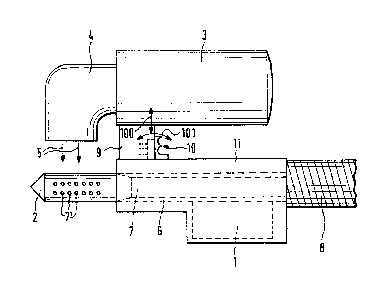Une partie des informations de ce site Web a été fournie par des sources externes. Le gouvernement du Canada n'assume aucune responsabilité concernant la précision, l'actualité ou la fiabilité des informations fournies par les sources externes. Les utilisateurs qui désirent employer cette information devraient consulter directement la source des informations. Le contenu fourni par les sources externes n'est pas assujetti aux exigences sur les langues officielles, la protection des renseignements personnels et l'accessibilité.
L'apparition de différences dans le texte et l'image des Revendications et de l'Abrégé dépend du moment auquel le document est publié. Les textes des Revendications et de l'Abrégé sont affichés :
| (12) Brevet: | (11) CA 1299616 |
|---|---|
| (21) Numéro de la demande: | 1299616 |
| (54) Titre français: | COMMUTATEUR POUR APPAREIL DE TRAITEMENT CAPILLAIRE |
| (54) Titre anglais: | SWITCH FOR A HAIR TREATMENT DEVICE |
| Statut: | Périmé et au-delà du délai pour l’annulation |
| (51) Classification internationale des brevets (CIB): |
|
|---|---|
| (72) Inventeurs : |
|
| (73) Titulaires : |
|
| (71) Demandeurs : | |
| (74) Agent: | SWABEY OGILVY RENAULT |
| (74) Co-agent: | |
| (45) Délivré: | 1992-04-28 |
| (22) Date de dépôt: | 1988-10-11 |
| Licence disponible: | S.O. |
| Cédé au domaine public: | S.O. |
| (25) Langue des documents déposés: | Anglais |
| Traité de coopération en matière de brevets (PCT): | Non |
|---|
| (30) Données de priorité de la demande: | ||||||
|---|---|---|---|---|---|---|
|
ABSTRACT OF THE INVENTION
What is described is a switch for a hair treatment device,
consisting of a winding mandrel (2) driven rotationally by a
motor (1) and of a hair dryer (3) whose outflow nozzle (4) is
directed perpendicularly upon the axis of the winding mandrel (2)
and tangentially to its circumference. A switch (10) is provided
to switch the hair dryer of the drive motor (1) of the winding
mandrel on and off, whereby the switch (10) can be shifted from
an upper position to a lower position towards the handle on a
housing element (11) made in form of a handle for an operator.
The switch (10) can furthermore be tilted out of the shifting
plane and is provided with two switching cams (12, 13), whereby
one switching cam (12) actuates a first contact (14) through
which the motor (1) of the winding mandrel (2) is switched on
independently of the tilting position of the switch (10) when
said switch is shifted into the lower position, closer to the
handle (10). The second switching cam (13) is of such
configuration as to cause the hair dryer (3) to be switched off
by activating a second contact (15) when tilting takes place.
(Fig. 2)
Note : Les revendications sont présentées dans la langue officielle dans laquelle elles ont été soumises.
Note : Les descriptions sont présentées dans la langue officielle dans laquelle elles ont été soumises.

2024-08-01 : Dans le cadre de la transition vers les Brevets de nouvelle génération (BNG), la base de données sur les brevets canadiens (BDBC) contient désormais un Historique d'événement plus détaillé, qui reproduit le Journal des événements de notre nouvelle solution interne.
Veuillez noter que les événements débutant par « Inactive : » se réfèrent à des événements qui ne sont plus utilisés dans notre nouvelle solution interne.
Pour une meilleure compréhension de l'état de la demande ou brevet qui figure sur cette page, la rubrique Mise en garde , et les descriptions de Brevet , Historique d'événement , Taxes périodiques et Historique des paiements devraient être consultées.
| Description | Date |
|---|---|
| Inactive : CIB de MCD | 2006-03-11 |
| Inactive : CIB de MCD | 2006-03-11 |
| Inactive : CIB de MCD | 2006-03-11 |
| Inactive : Demande ad hoc documentée | 1995-04-28 |
| Le délai pour l'annulation est expiré | 1994-10-28 |
| Lettre envoyée | 1994-04-28 |
| Accordé par délivrance | 1992-04-28 |
Il n'y a pas d'historique d'abandonnement
Les titulaires actuels et antérieures au dossier sont affichés en ordre alphabétique.
| Titulaires actuels au dossier |
|---|
| ABC-ELEKTROGERATE VOLZ, GMBH & CO. |
| Titulaires antérieures au dossier |
|---|
| HUBERT THEIMER |